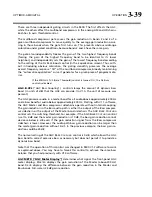
3-30
OPERATION ORBAN
MODEL
9400
tion on poor quality speakers by over-equalizing the bass. Be careful!
The moderate-slope (12 dB/octave) shelving boost achieves a bass boost that is more
audible on smaller receivers, but which can sound boomier on high-quality receivers.
The steep-slope (18 dB/octave) shelving boost creates a solid, punchy bass from the
better consumer receivers and home theater systems with decent bass response. The
6 dB/octave shelving boost is like a conventional tone control and creates the most
mid-bass boost, yielding a “warmer” sound. Because it affects the mid-bass fre-
quency range, where the ear is more sensitive than it is to very low bass, the 6
dB/octave slope can create more apparent bass level at the cost of bass “punch.”
There are no easy choices here; you must choose the characteristic you want by
identifying your target audience and the receivers they are most likely to be using.
In many cases, you will not want to use any boost at all for general-purpose AM
programming, because this can exaggerate rumble and other low frequency noise.
Additionally, large amounts of boost will increase the gain reduction in the lowest
band of the multiband compressor, which may have the effect of reducing some fre-
quencies below 100 or 200 Hz (depending on the setting of the
B1/B2
X
OVER
con-
trol). So be aware the large fixed bass boosts may have a different effect than you
expect because of the way that they interact with the multiband compressor.
Low Frequency Parametric Equalizer
is a specially designed parametric equalizer
whose boost and cut curves closely emulate those of a classic Orban analog para-
metric equalizer with conventional bell-shaped curves (within
0.15 dB worst-case).
This provides warm, smooth, “analog-sounding” equalization.
LF FREQ
determines the center frequency of the equalization, in Hertz.
Range is 20-500Hz.
LF GAIN
determines the amount of peak boost or cut (in dB) over a
10
dB range.
LF WIDTH
determines the bandwidth of the equalization, in octaves. The
range is 0.8-4.0 octaves. If you are unfamiliar with using a parametric
equalizer, 1.5 octaves is a good starting point. These curves are relatively
broad because they are designed to provide overall tonal coloration,
rather than to notch out small areas of the spectrum.
Although a certain amount of low-frequency boost must be used along with the
high frequency boost in order to obtain a balanced sound on analog AM radios for
MW,
do so conservatively!
Use the auto radios with most bass (all of which usually
have a peaky mid-bass when you listen through the standard dashboard speaker) as
a “worst case” reference. Do not boost the bass so much that your reference radio
becomes muddy or boomy. With correct bass boost, your table radio will have only
moderate bass, and your pocket radio will sound thin and tinny.
For example, a 6dB boost corresponds to a 400% increase in power! More than 6dB
of bass boost will strain many transmitters, unnecessarily increasing power supply
bounce and IM distortion problems. (The bass boost is further limited dynamically in
the multiband clipper
see immediately below.) Excessive bass boost will also cause
many dashboard speakers to sound unacceptably muddy.
Summary of Contents for Optimod-AM 9400
Page 1: ...Operating Manual OPTIMOD AM 9400 Digital Audio Processor Version 1 2 Software...
Page 7: ...Operating Manual OPTIMOD AM 9400 Digital Audio Processor Version 1 2 Software...
Page 52: ......
Page 204: ......
Page 232: ......
Page 260: ......
Page 261: ...OPTIMOD AM DIGITAL TECHNICAL DATA 6 29...
Page 267: ...OPTIMOD AM DIGITAL TECHNICAL DATA 6 35 CPU Module...
Page 273: ...OPTIMOD AM DIGITAL TECHNICAL DATA 6 41 RS232 BOARD PARTS LOCATOR...
Page 275: ...OPTIMOD AM DIGITAL TECHNICAL DATA 6 43 8300 POWER SUPPLY PARTS LOCATOR...
Page 284: ...6 52 TECHNICAL DATA ORBAN MODEL 9400 DSP BOARD PARTS LOCATOR DRAWING 32170 000 14...
Page 292: ...6 60 TECHNICAL DATA ORBAN MODEL 9400 DISPLAY BOARD PARTS LOCATOR...
Page 293: ...OPTIMOD AM DIGITAL TECHNICAL DATA 6 61 DISPLAY BOARD...
















































